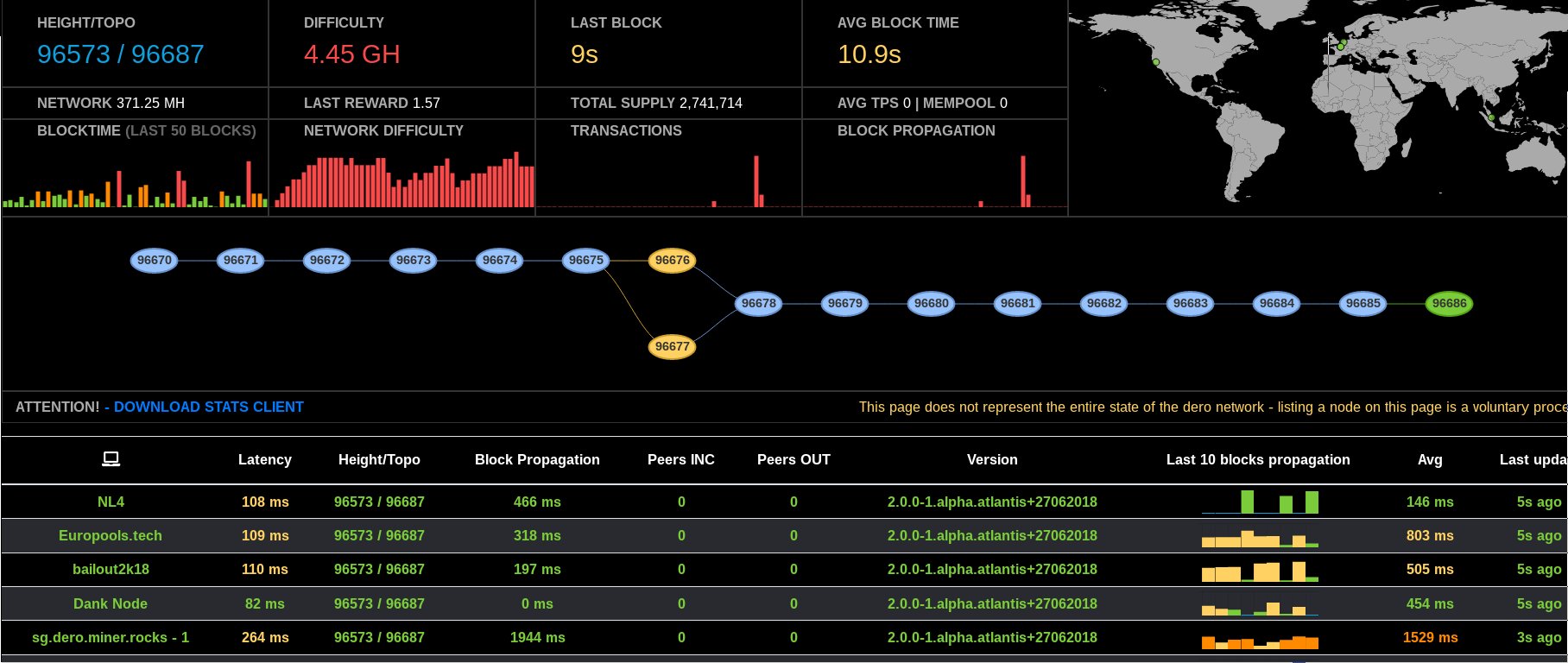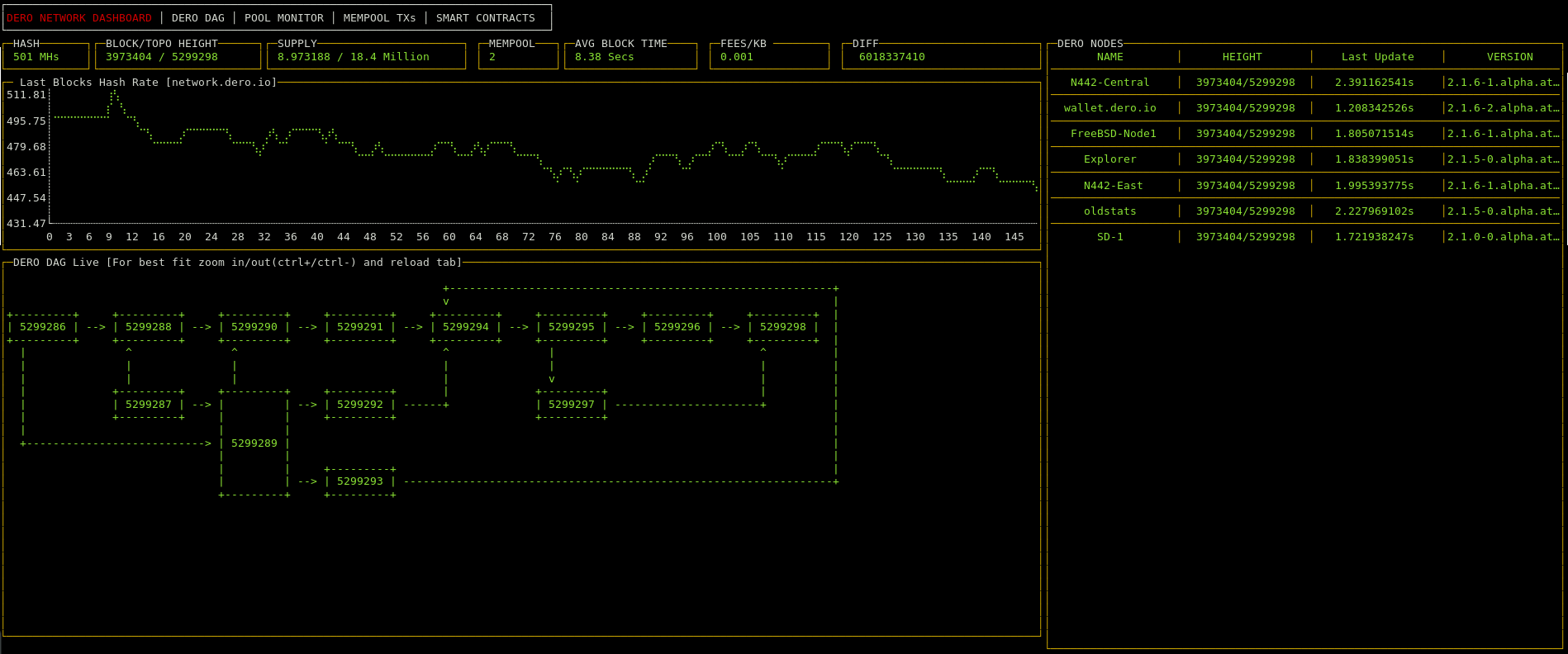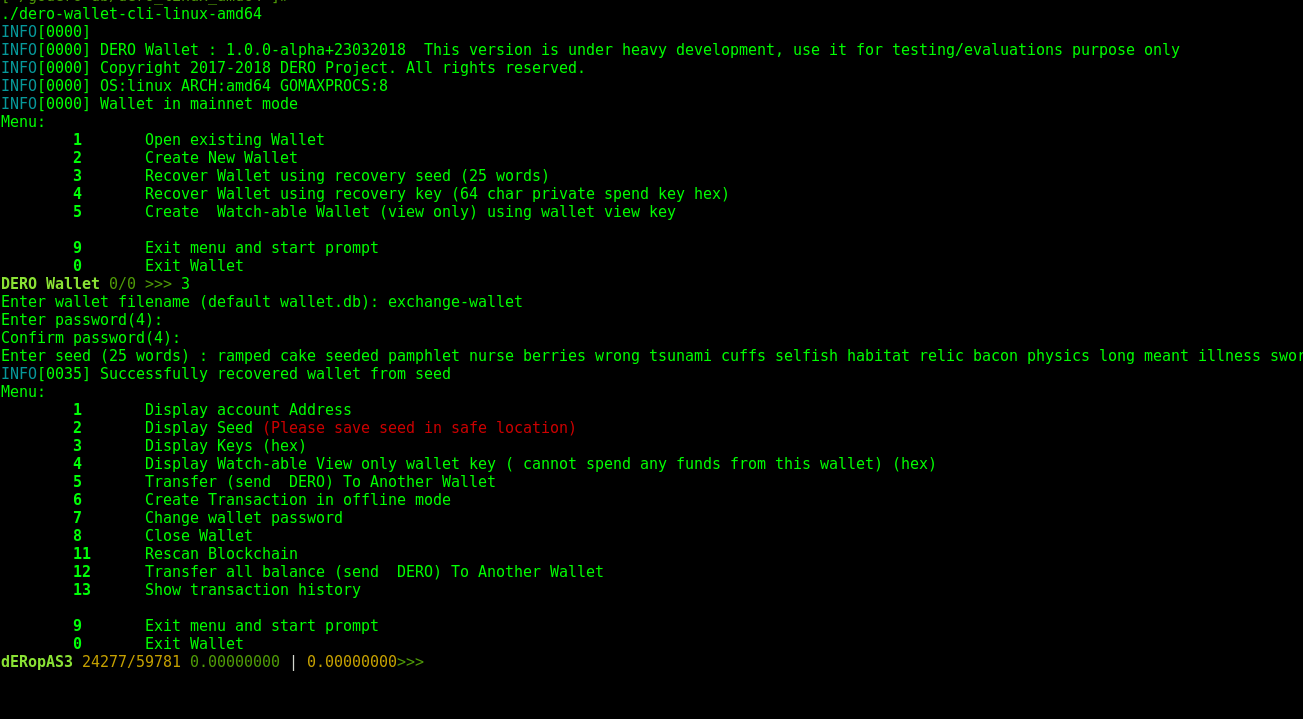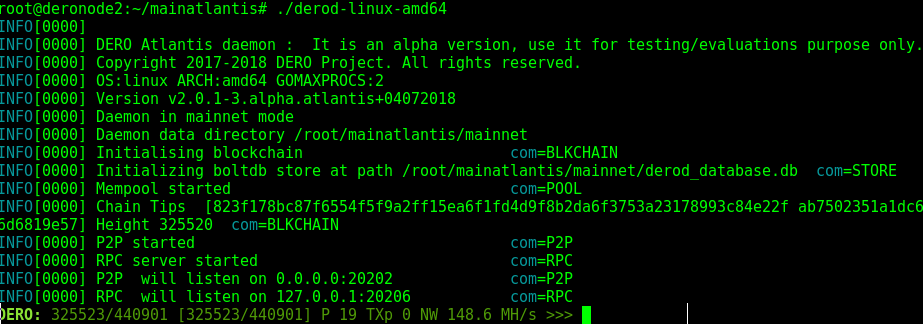Explorer Source Twitter Discord Wiki Github DERO CryptoNote Mainnet Stats Mainnet WebWallet
Homomorphic encryption is a form of encryption allowing one to perform calculations on encrypted data without decrypting it first. The result of the computation is in an encrypted form, when decrypted the output is the same as if the operations had been performed on the unencrypted data.
Homomorphic encryption can be used for privacy-preserving outsourced storage and computation. This allows data to be encrypted and out-sourced to commercial cloud environments for processing, all while encrypted. In highly regulated industries, such as health care, homomorphic encryption can be used to enable new services by removing privacy barriers inhibiting data sharing. For example, predictive analytics in health care can be hard to apply via a third party service provider due to medical data privacy concerns, but if the predictive analytics service provider can operate on encrypted data instead, these privacy concerns are diminished.
DERO is pleased to announce release of DERO Homomorphic Encryption Protocol testnet. DERO will migrate from exisiting CryptoNote Protocol to it's own DERO Homomorphic Encryption Blockchain Protocol(DHEBP).
- ABOUT DERO PROJECT
- DERO HE Features
- DERO HE TX Sizes
- DERO Crypto
- DERO HE PORTS
- Technical
- DERO blockchain salient features
- DERO Innovations
- DERO Mining
- DERO Installation
- Next Step After DERO Installation
- DERO Explorer
- Proving DERO Transactions
DERO is decentralized DAG(Directed Acyclic Graph) based blockchain with enhanced reliability, privacy, security, and usability. Consensus algorithm is PoW based on DERO AstroBWT: ASIC/FPGA/GPU resistant CPU mining algorithm . DERO is industry leading and the first blockchain to have bulletproofs, TLS encrypted Network.
DERO is the first crypto project to combine a Proof of Work blockchain with a DAG block structure and fully anonymous transactions based on Homomorphic Encryption. The fully distributed ledger processes transactions with a sixty-seconds average block time and is secure against majority hashrate attacks. DERO will be the first Homomorphic Encryption based blockchain to have smart contracts on its native chain without any extra layers or secondary blockchains. At present DERO has Smart Contracts on old CryptoNote protocol testnet.
-
Homomorphic account based model [First privacy chain to have this.](Check blockchain/transaction_execute.go line 82-95).
-
Instant account balances[ Need to get 66 bytes of data only from the blockchain].
-
DAG/MINIDAG with 1 miniblock every second
-
Mining Decentralization.No more mining pools, daily 100000 reward blocks, no need for pools and thus no attacks
-
Erasure coded blocks, lower bandwidth requirements, very low propagation time.
-
No more chain scanning or wallet scanning to detect funds, no key images etc.
-
Truly light weight and efficient wallets.
-
Fixed per account cost of 66 bytes in blockchain[Immense scalability].
-
Perfectly anonymous transactions with many-out-of-many proofs [bulletproofs and sigma protocol]
-
Deniability
-
Fixed transaction size say ~2.5KB (ring size 8) or ~3.4 KB (ring size 16) etc based on chosen anonymity group size[ logarithmic growth]
-
Anonymity group can be chosen in powers of 2.
-
Allows homomorphic assets ( programmable SCs with fixed overhead per asset ), with open Smart Contract but encrypted data [Internal testing/implementation not on this current testnet branch].
-
Allows open assets ( programmable SCs with fixed overhead per asset ) [Internal testing/implementation not on this current testnet branch]
-
Allows chain pruning on daemons to control growth of data on daemons.
-
Transaction generation takes less than 25 ms.
-
Transaction verification takes even less than 25ms time.
-
No trusted setup, no hidden parameters.
-
Pruning chain/history for immense scalibility[while still secured using merkle proofs].
-
Example disk requirements of 1 billion accounts ( assumming it does not want to keep history of transactions, but keeps proofs to prove that the node is in sync with all other nodes)
Requirement of 1 account = 66 bytes Assumming storage overhead per account of 128 bytes ( constant ) Total requirements = (66 + 128)GB ~ 200GB Assuming we are off by factor of 4 = 800GB -
Note that, Even after 1 trillion transactions, 1 billion accounts will consume 800GB only, If history is not maintained, and everything still will be in proved state using merkle roots. And so, Even Raspberry Pi can host the entire chain.
-
Senders can prove to receiver what amount they have send (without revealing themselves).
-
Worlds first Erasure Coded Propagation protocol, which allows 100x block size without increasing propagation delays.
-
Entire chain is rsyncable while in operation.
-
Testnet released with source code.
| Ring Size | DEROHE TX Size |
|---|---|
| 2 | 1553 bytes |
| 4 | 2013 bytes |
| 8 | 2605 bytes |
| 16 | 3461 bytes |
| 32 | 4825 bytes |
| 64 | 7285 bytes |
| 128 | 11839 bytes |
| 512 | ~35000 bytes |
NB: Plan to reduce TX sizes further.
Secure and fast crypto is the basic necessity of this project and adequate amount of time has been devoted to develop/study/implement/audit it. Most of the crypto such as ring signatures have been studied by various researchers and are in production by number of projects. As far as the Bulletproofs are considered, since DERO is the first one to implement/deploy, they have been given a more detailed look. First, a bare bones bulletproofs was implemented, then implementations in development were studied (Benedict Bunz,XMR, Dalek Bulletproofs) and thus improving our own implementation.
Some new improvements were discovered and implemented (There are number of other improvements which are not explained here). Major improvements are in the Double-Base Double-Scalar Multiplication while validating bulletproofs. A typical bulletproof takes ~15-17 ms to verify. Optimised bulletproofs takes ~1 to ~2 ms(simple bulletproof, no aggregate/batching). Since, in the case of bulletproofs the bases are fixed, we can use precompute table to convert 64*2 Base Scalar multiplication into doublings and additions (NOTE: We do not use Bos-Coster/Pippienger methods). This time can be again easily decreased to .5 ms with some more optimizations. With batching and aggregation, 5000 range-proofs (~2500 TX) can be easily verified on even a laptop. The implementation for bulletproofs is in github.com/deroproject/derosuite/crypto/ringct/bulletproof.go , optimized version is in github.com/deroproject/derosuite/crypto/ringct/bulletproof_ultrafast.go
There are other optimizations such as base-scalar multiplication could be done in less than a microsecond. Some of these optimizations are not yet deployed and may be deployed at a later stage.
Mainnet:
P2P Default Port: 10101
RPC Default Port: 10102
Wallet RPC Default Port: 10103
Testnet:
P2P Default Port: 40401
RPC Default Port: 40402
Wallet RPC Default Port: 40403
For specific details of current DERO core (daemon) implementation and capabilities, see below:
- DAG: No orphan blocks, No soft-forks.
- BulletProofs: Zero Knowledge range-proofs(NIZK)
- AstroBWT: This is memory-bound algorithm. This provides assurance that all miners are equal. ( No miner has any advantage over common miners).
- P2P Protocol: This layers controls exchange of blocks, transactions and blockchain itself.
- Pederson Commitment: (Part of ring confidential transactions): Pederson commitment algorithm is a cryptographic primitive that allows user to commit to a chosen value while keeping it hidden to others. Pederson commitment is used to hide all amounts without revealing the actual amount. It is a homomorphic commitment scheme.
- Homomorphic Encryption: Homomorphic Encryption is used to to do operations such as addition/substraction to settle balances with data being always encrypted (Balances are never decrypted before/during/after operations in any form.).
- Homomorphic Ring Confidential Transactions: Gives untraceability , privacy and fungibility while making sure that the system is stable and secure.
- Core-Consensus Protocol implemented: Consensus protocol serves 2 major purpose
- Protects the system from adversaries and protects it from forking and tampering.
- Next block in the chain is the one and only correct version of truth ( balances).
- Proof-of-Work(PoW) algorithm: PoW part of core consensus protocol which is used to cryptographically prove that X amount of work has been done to successfully find a block.
- Difficulty algorithm: Difficulty algorithm controls the system so as blocks are found roughly at the same speed, irrespective of the number and amount of mining power deployed.
- Serialization/De-serialization of blocks: Capability to encode/decode/process blocks .
- Serialization/De-serialization of transactions: Capability to encode/decode/process transactions.
- Transaction validity and verification: Any transactions flowing within the DERO network are validated,verified.
- Socks proxy: Socks proxy has been implemented and integrated within the daemon to decrease user identifiability and improve user anonymity.
- Interactive daemon can print blocks, txs, even entire blockchain from within the daemon
- status, diff, print_bc, print_block, print_tx and several other commands implemented
- GO DERO Daemon has both mainnet, testnet support.
- Enhanced Reliability, Privacy, Security, Useability, Portabilty assured.
- DAG Based: No orphan blocks, No soft-forks.
- 51% Attack resistant.
- 60 Second Block time.
- Extremely fast transactions with one minute/block confirmation time.
- SSL/TLS P2P Network.
- Homomorphic: Fully Encrypted Blockchain
- Dero Fastest Rocket BulletProofs: Zero Knowledge range-proofs(NIZK).
- Ring signatures.
- Fully Auditable Supply.
- DERO blockchain is written from scratch in Golang. See all unique blockchains from scratch.
- Developed and maintained by original developers.
Following are DERO first and leading innovations.
DERO DAG implementation builds outs a main chain from the DAG network of blocks which refers to main blocks (100% reward) and side blocks (8% rewards).

DERO DAG Screenshot Live

DERO DAG Screenshot Live
Traditional Blockchains process blocks as single unit of computation(if a double-spend tx occurs within the block, entire block is rejected). As soon as a block is found, it is sent to all its peers.DERO blockchain erasure codes the block into 48 chunks, dispersing and chunks are dispersed to peers randomly.Any peer receiving any 16 chunks( from 48 chunks) can regerate the block and thus lower overheads and lower propagation time.
Traditional Blockchains process blocks as single unit of computation(if a double-spend tx occurs within the block, entire block is rejected). However DERO network accepts such blocks since DERO blockchain considers transaction as a single unit of computation.DERO blocks may contain duplicate or double-spend transactions which are filtered by client protocol and ignored by the network. DERO DAG processes transactions atomically one transaction at a time.
-
Dero ultrafast bulletproofs optimization techniques in the form used did not exist anywhere in publicly available cryptography literature at the time of implementation. Please contact for any source/reference to include here if it exists. Ultrafast optimizations verifies Dero bulletproofs 10 times faster than other/original bulletproof implementations. See: https://github.com/deroproject/derosuite/blob/master/crypto/ringct/bulletproof_ultrafast.go
-
DERO rocket bulletproof implementations are hardened, which protects DERO from certain class of attacks.
-
DERO rocket bulletproof transactions structures are not compatible with other implementations.
Also there are several optimizations planned in near future in Dero rocket bulletproofs which will lead to several times performance boost. Presently they are under study for bugs, verifications, compatibilty etc.
DERO DAG implementation builds outs a main chain from the DAG network of blocks which refers to main blocks (100% reward) and side blocks (8% rewards). Side blocks contribute to chain PoW security and thus traditional 51% attacks are not possible on DERO network. If DERO network finds another block at the same height, instead of choosing one, DERO include both blocks. Thus, rendering the 51% attack futile.
DERO is written in golang and very easy to install both from source and binary.
- Install Golang, Golang version 1.12.12 required.
- In go workspace:
go get -u github.com/deroproject/derohe/... - Check go workspace bin folder for binaries.
- For example on Linux machine following binaries will be created:
- derod-linux-amd64 -> DERO daemon.
- dero-wallet-cli-linux-amd64 -> DERO cmdline wallet.
- explorer-linux-amd64 -> DERO Explorer. Yes, DERO has prebuilt personal explorer also for advance privacy users.
Download DERO binaries for ARM, INTEL, MAC platform and Windows, Mac, FreeBSD, OpenBSD, Linux etc. operating systems.
Most users required following binaries:
Windows 7-10, Server 64bit/amd64
Windows 32bit/x86/386
Linux 64bit/amd64
Linux 32bit/x86
FreeBSD 64bit/amd64
OpenBSD 64bit/amd64
Mac OS
Contact for support of other hardware and OS.
Running DERO daemon supports DERO network and shows your support to privacy.
Run derod.exe or derod-linux-amd64 depending on your operating system. It will start syncing.
- DERO daemon core cryptography is highly optimized and fast.
- Use dedicated machine and SSD for best results.
- VPS with 2-4 Cores, 4GB RAM,15GB disk is recommended.
Dero cmdline wallet is most reliable and has support of all functions. Cmdline wallet is most secure and reliable.
DERO cmdline wallet is menu based and very easy to operate.
Use various options to create, recover, transfer balance etc.
NOTE: DERO cmdline wallet by default connects DERO daemon running on local machine on port 20206.
If DERO daemon is not running start DERO wallet with --remote option like following:
./dero-wallet-cli-linux-amd64 --remote

DERO Cmdline Wallet Screenshot
DERO Explorer is used to check and confirm transaction on DERO Network.
DERO testnet Explorer is used to check and confirm transaction on DERO Network.
DERO users can run their own explorer on local machine and can browse on local machine port 8080.
 DERO EXPLORER Screenshot
DERO EXPLORER Screenshot
DERO blockchain is completely private, so anyone cannot view, confirm, verify any other's wallet balance or any transactions.
So to prove any transaction you require TXID and deroproof.
deroproof can be obtained using get_tx_key command in dero-wallet-cli.
Enter the TXID and deroproof in DERO EXPLORER
 DERO Explorer Proving Transaction
DERO Explorer Proving Transaction
